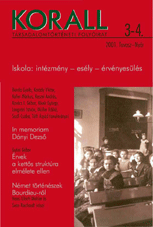Kézművesek és kézművescsaládok Tornán a 19. században II. rész
Artisans and artisan families in market-town Torna in the nineteenth century Part II.
Author(s): Péter Pozsgai Subject(s): History
Published by: KORALL Társadalomtörténeti Egyesület
Keywords: Hungary; social history; 19th century; family; Torna; craftsmen; household; census; profession
Summary/Abstract: In the second part of his study the author examines how the landownership and the marriages influenced the continuity of artisan families and the mobility of the individual artisans in the market town. With the help of a nominative data base the life courses of the individual artisans and the artisan families could be followed "from appearance to disappearance". The method made possible the reconstruction of artisan households (1857, 1869), the study of demographic behaviour and life-cycles of artisan families, the examination of transmission of property and handicraft. In the course of the research two sub-groups of artisans proved the most stable: partly the offsprings of the "old market town families" (with small plots of land but embedded into the local social network), partly the one- or two-generational migrant-families where the artisan could have managed to marry a bride of Torna-origin and purchase a larger plot of land. By examining the household structure and the life-cycles of the artisan families the author concludes that the census registers can be used for household reconstruction to only a limited extent. The results so far show that in cases where census-takers in the 1857 and 1869 census distinguished a number of related co-residentparties (Wohnpartei) within the same house, in the case of the market town this did not always reflect the reality of the economic and property entities constituted by these families (especially the landowner artisans). After reconstructing the artisan households and analysing the family life-cycles the findings have shown the significance of complex households, especially of the stem family form in the household cycles of land-owning families (larger plots), while the landless or smallholder artisan families went under more simple phases during the course of their life-cycle.
Journal: Korall - Társadalomtörténeti folyóirat
- Issue Year: 2001
- Issue No: 3-4
- Page Range: 266-296
- Page Count: 31
- Language: Hungarian

